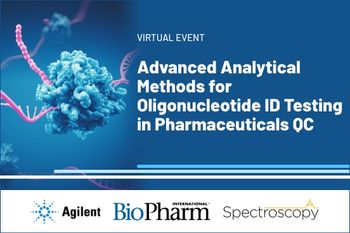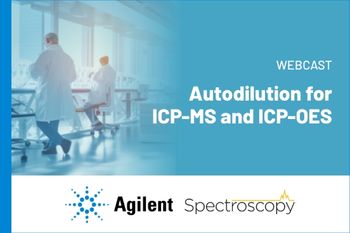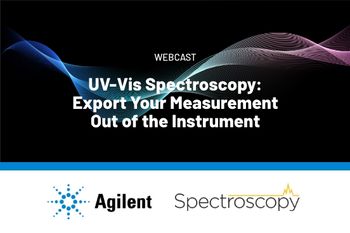
Gain insights into improving efficiency and accuracy in elemental analysis through automated dilution technology. Learn about the key capabilities of the Agilent ADS 2 system and its seamless integration with ICP-MS and ICP-OES workflows.

Gain insights into improving efficiency and accuracy in elemental analysis through automated dilution technology. Learn about the key capabilities of the Agilent ADS 2 system and its seamless integration with ICP-MS and ICP-OES workflows.

Optical fibers in ultraviolet-visible (UV-Vis) spectroscopy can enable measurements outside the traditional sample compartment. This paper details the components needed for fiber optic systems, such as couplers and probes, and reviews the performance of Agilent's Cary series instruments. It is crucial to choose the right fiber optic setup for a specific lab’s needs to ensure accurate and efficient measurements.

Melting point determination using ultraviolet-visible (UV-Vis) spectrophotometry can be used as a sequence-specific method for identifying therapeutic oligonucleotides in pharmaceutical quality control. This method offers a simple, highly selective approach to differentiate between isomers and ensure the integrity of oligonucleotide active pharmaceutical ingredients (APIs) and drug products.

Transmittance and reflectance measurements, which are useful for estimating the effects of various physical processes, can include thermal treatments, ionizing radiation exposure, optical exposure, and mechanical treatments—on both crystals and thin films.

The Cary 3500 UV-Vis systems use temperature-controlled UV-Vis spectroscopy to analyze molecules' thermal stability. They are essential for nucleic acid quantification quality control by measuring absorbance at 260 nm and performing thermal melt identification verification. Melting temperature (Tm) analysis is key for studying nucleic acid denaturation.

All starting materials, including APIs, must undergo analytical identity (ID) determination before pharmaceutical manufacturing to ensure drug safety. Oligonucleotides pose challenges for ID due to sequence specificity. Melting temperatures (Tm) combined with intact mass measurements offer a solution using UV-based spectrometry for precise Tm determination at Vetter Pharma.

Vetter Pharma successfully uses the Cary 3500 UV-Vis to optimize thermal melt measurements of oligonucleotide-based pharmaceuticals.

Characterizing biomolecules such as oligonucleotides and proteins is critical to better understanding biochemical and molecular processes. UV-Vis spectroscopy is widely used for stability studies, protein aggregation, DNA quantification and purity, and enzyme activity. The Cary 3500 UV-Vis offers advanced features to provide accurate and reproducible results.

The drug discovery process involves identifying and characterizing drug targets to find lead compounds. Biochemical characterization (e.g., molecular weight, solubility, thermal stability) is crucial for protein therapeutics. Thermal stability studies measuring melting temperatures help understand protein stability, ligand-binding, and optimal storage, aiding drug development and commercialization.

Webinar Date/Time: Tue, Dec 3, 2024 11:00 AM EST

Webinar Date/Time: Session 1: Tues, Dec 5, 2024, at 12:00 PM BST | 1:00 PM CET Session 2: Tues, Dec 5, 2024, at 11:00 AM PST | 2:00 PM EST | 7:00 PM GMT Session 3: Wed, Dec 6, 2024, at 9:30 AM IST | 12:00 PM SGT | 1:00 PM JST | 3:00 PM AEDT

The Agilent Vaya Raman system is a handheld spectrometer capable of identifying raw materials through transparent and opaque containers. This white paper discusses some of the benefits of deploying a Vaya system in a pharmaceutical warehouse, to simplify and accelerate the ID verification of raw materials at receipt.

This study demonstrates the through-opaque-container analysis capability of the Agilent Vaya handheld Raman spectrometer by performing measurements on a range of common excipients and active ingredients within blue barrels.

Webinar Date/Time: Thursday, September 26, 2024 Morning Session: 10:00 AM EDT | 7:00 AM PDT | 3:00 PM BST | 4:00 PM CEST Afternoon Sesson: 12:30 PM EDT | 9:30 AM PDT | 5:30 PM BST | 6:30 PM CEST

Webinar Date/Time: Thursday, October 10, 2024 at 10 AM BST | 11 AM CEST

Webinar Date/Time: Thursday, September 12th, 2024 English Session: 10:00 AM BST | 11:00 AM CEST French Session: 10:00 AM BST | 11:00 AM CEST

This study demonstrates the through-opaque-container analysis capability of the Agilent Vaya handheld Raman spectrometer by performing measurements on a range of common excipients and active ingredients within blue barrels. Spatially offset Raman spectroscopy (SORS) is the unique Agilent technology that is the basis of the unique Vaya container subtraction algorithm. This technology can optimize the spectra to provide the clearest signature of contents with the minimum amount of container interference. Verification of raw materials directly through plastic barrels provides efficient raw material identification (RMID) workflows in the warehouse without the need for specialized personnel or controlled sampling environments.

Handheld Raman spectrometers can distinguish raw materials through transparent and opaque packaging containers. This application note demonstrates the use of the handheld Agilent Vaya Raman raw material identity verification system based on spatially offset Raman spectroscopy (SORS) for chemical ID verification and testing of mRNA lipid nanoparticle (LNP) components through transparent glass and white opaque polyethylene containers.

Over 85% of scientific organizations have incorporated environmental sustainability into their long term goals and commitments. Agilent helps scientists reach their sustainability goals without compromising results or productivity, with products developed with the environment in mind. The Accountability, Consistency, and Transparency Label (ACT label) helps to communicate the environmental impact of manufacturing, operation, and disposal of scientific products and packaging, helping scientists make green equipment decisions. Agilent Vaya handheld Raman spectrometers are ACT Label certified and enable zero-waste workflows, offering a green choice for raw material identification workflows.

Magnesium, calcium, or zinc stearates are commonly used in pharmaceutical drug manufacturing. While these metal stearates exhibit similar chemical properties, they are not necessarily interchangeable in manufacturing processes. It is critical therefore that they are identified and differentiated at receipt in the warehouse to avoid process disruptions. Accurately differentiating stearate analogs at receipt by Raman spectroscopy has historically been challenging. Given the similarities of the spectra of the compounds, sophisticated chemometric software is often needed to build stearate models that are then used to identify them. This study shows that the Agilent Vaya handheld Raman spectrometer with Spatially Offset Raman Spectroscopy (SORS) can identify metal stearates in their original primary packaging, without the need for complex chemometric software packages. The handheld Vaya Raman enables the selective verification of stearates using a two-criteria decision algorithm combined with the "Analogous Sample" software feature.

This Agilent application note details the use of a Cary 5000 UV-Vis-NIR spectrophotometer with a universal measurement accessory for the optical characterization and reverse-engineering of thin films. It emphasizes the importance of multi-angle spectral photometric data in assessing the optical parameters of thin films, which is crucial for quality control in manufacturing processes.

This Agilent application note discusses the Cary 7000 UMS, a system for mapping coated wafers using UV-Vis spectral reflection and transmission measurements. It introduces a new autosampler for automated, high-resolution mapping of large samples and demonstrates its utility with a zinc tin oxide layer on a sapphire substrate.

The Agilent Cary 5000 UV-Vis-NIR spectrophotometer, equipped with a Praying Mantis diffuse reflectance accessory, is ideal for analyzing catalyst powders. It provides valuable insights into chemical transformations across a broad temperature range, from 20 to 250 °C, enhancing the understanding of catalytic processes.

Webinar Date/Time: Wednesday, June 26th, 2024 at 8am PDT | 11am EDT | 4pm BST | 5pm CEST

The Agilent Advanced Dilution System 2 (ADS 2) is a new two-syringe autodilution system for Agilent ICP-MS instruments that can automatically dilute stock standards and samples up to 400 times. Agilent has developed the ADS 2 to improve the efficiency and cost-per-sample of elemental analyses by automating calibration, sample dilution, and the reanalysis of out-of-range samples.

Inductively Coupled Plasma Mass Spectrometry (ICP-MS) is a versatile multi-elemental analysis technique that is widely used across various sectors due to its high sensitivity and selectivity. Many environmental, food, pharmaceutical, and material testing laboratories that rely on high-throughput methods have benefited from the robustness, reliability, and high performance of Agilent ICP-MS instruments. As laboratories look to further reduce inefficiencies in their workflows and lower demands on staff, there is a shift towards automating manual tasks to improve overall productivity.

To manage the large sample loads that are typical of many environmental testing laboratories, ICP-OES users need instruments that deliver fast sample-to-sample analysis times, while generating consistently high-quality results. Agilent has developed the Advanced Dilution System (ADS 2) for Agilent ICP-OES (and ICP-MS) instruments. The ADS 2 is an intelligent autodilution system, which includes an Advanced Valve System (AVS). The system improves the productivity of ICP-OES workflows by automating many manual tasks throughout the analytical sequence.


Single cell ICP-MS (scICP-MS) is increasingly seen as a powerful and fast tool for the measurement of elements in individual cells, mainly due to the high sensitivity and selectivity of ICP-MS. Analysis is performed in the same way as single nanoparticle (spICP-MS) analysis, which has become a well-established technique for the analysis of nanoparticles and particles.

Watch this video featuring Darren Robey and Dr. Wesam Alwan from Agilent Technologies to gain insights into the future trends shaping microplastics research and the challenges of their characterization. Discover the essential components necessary for accurate microplastics analysis and learn how the Agilent 8700 LDIR system addresses these challenges. Offering rapid and precise analysis capabilities, along with easy sample preparation methods that minimize contamination, the Agilent 8700 LDIR system is at the forefront of advancing microplastics research.

Published: April 10th 2024 | Updated:

Published: December 19th 2024 | Updated:

Published: August 5th 2022 | Updated:

Published: March 2nd 2023 | Updated:

Published: May 6th 2021 | Updated:

Published: March 12th 2024 | Updated: